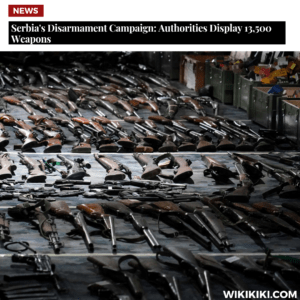Serbia has initiated a comprehensive disarmament campaign in the wake of two tragic mass shootings that occurred within days of each other. In an effort to crack down on the widespread availability of firearms, the Serbian government declared a one-month amnesty period, urging citizens to surrender unregistered weapons. The response to this call has been significant, with approximately 13,500 weapons turned in, including guns, grenades, and even rocket launchers. This article explores the details of the disarmament campaign, the reasons behind it, and the implications for gun control in Serbia.
Also Read: Dubai Retains No.1 Global Ranking for Attracting Greenfield FDI Projects

Reason for Serbia’s Disarmament Campaign
Two mass shootings shook Serbia, leaving the nation in shock and prompting demands for action. The first incident involved a 13-year-old boy who took his father’s gun to school and opened fire on his classmates. The second shooting, which occurred the following day, involved a 20-year-old man using an automatic weapon to randomly shoot in a rural area. These horrifying events resulted in the deaths of 17 people, many of them children. The public outcry and the need for immediate measures to address gun violence became apparent.
Displaying the Surrendered Weapons
To highlight the success of the disarmament campaign, populist President Aleksandar Vucic accompanied top police officials to an arms exhibition near the town of Smederevo. Thousands of surrendered weapons were displayed, including hand grenades, automatic weapons, and even anti-tank rocket launchers. These weapons, previously in the possession of individuals, are now being collected and stored at a police depot. The exhibition serves as a visual representation of the magnitude of the issue and emphasizes the government’s dedication to addressing it.
A significant portion of the surrendered weapons were illegal firearms, constituting nearly half of the total items handed over. The other half consisted of registered weapons that citizens voluntarily decided to part with. It is worth noting that Serbia has a history of weapon accumulation from the 1990s wars in the Balkans. Despite previous amnesty campaigns, the success rate in reducing illegal weapons has been limited. This current initiative aims to make a more substantial impact by encouraging citizens to relinquish their firearms.
Also Read: Former ByteDance Executive Said CCP has Access to TikTok’s US User Data
Addressing Serbia’s High Gun Ownership
Serbia has one of the highest rates of gun ownership in Europe. Many of these firearms are remnants from the conflicts of the 1990s and are held illegally. To address this issue, the government plans to tighten controls on gun owners and shooting ranges. These measures are intended to ensure responsible ownership and prevent firearms from falling into the wrong hands. By regulating the acquisition, possession, and use of firearms, Serbia aims to reduce the risks associated with widespread gun ownership.
Public Protests and Calls for Resignation
The mass shootings sparked large-scale protests in Belgrade and other Serbian cities, where demonstrators demanded the resignation of government ministers and a ban on television stations promoting violence and hosting war criminals. Opposition politicians have accused the populist authorities of fueling violence, hate speech, and autocratic control over institutions. Protesters have blocked major bridges and highways, expressing their anger and frustration at the government’s handling of the situation.
Implications and Future Outlook
The disarmament campaign in Serbia signifies a response to the public outcry for stricter gun control measures. By encouraging citizens to surrender their firearms, the government aims to enhance public safety and reduce the risk of future mass shootings. The display of thousands of surrendered weapons serves as a visual representation of the magnitude of the issue and underscores the government’s commitment to addressing it.
However, the success of the campaign will depend on various factors. The government’s ability to enforce stricter controls on gun owners and shooting ranges will be crucial in preventing firearms from ending up in the wrong hands. Additionally, ongoing efforts to regulate the acquisition, possession, and use of firearms will play a vital role in curbing gun violence in the long term.
The mass shootings and subsequent protests have also highlighted deeper societal issues in Serbia. The demand for the resignation of government ministers and calls for media reform reflect a broader discontent with the current administration. The government will need to address these concerns and engage in open dialogue with the public to restore trust and foster a safer society.
Looking ahead, the success of the disarmament campaign will be measured by the reduction in illegal weapons and the overall improvement in public safety. It is crucial for the government to follow through on its promises, enforce stricter regulations, and provide support for mental health services and initiatives that address the root causes of violence. Only through a comprehensive approach can Serbia hope to overcome its history of gun violence and create a safer future for its citizens.
Also Read: Dopamine Detox: How to Boost Productivity using Dopamine Detox
Serbia’s Gun Culture and Historical Context
Serbia has a significant number of firearms per capita, largely due to the legacy of the 1990s wars in the Balkans. Many weapons from that era remain in illegal possession. Previous attempts at weapons amnesties have had limited success in curbing the availability of firearms. The disarmament campaign aims to address this historical context and reduce the number of weapons circulating in the country.
Amnesty Period and Future Consequences
The Serbian government declared a one-month amnesty period for citizens to surrender unregistered weapons without facing legal consequences. However, after the amnesty period ends, individuals caught with illegal weapons could face severe punishments, including prison sentences of up to 15 years. President Vucic has emphasized the need for strict punishments to deter illegal weapon possession, questioning the necessity of automatic weapons and excessive firearms in civilian hands. Surrendered weapons will be examined and potentially repurposed for use by the country’s armed forces.
Addressing the Root Causes of Violence
While the disarmament campaign is a crucial step, it also highlights the need for comprehensive measures to address the root causes of violence in Serbian society. The recent mass shootings have shed light on various underlying issues that contribute to the prevalence of gun violence. To effectively tackle this problem, the Serbian government is considering a multi-faceted approach:
- Mental Health Support: There is a growing recognition that mental health plays a significant role in acts of violence. Efforts are underway to improve access to mental health services and raise awareness about the importance of early intervention and treatment. Schools and communities are being encouraged to prioritize mental health education and provide support for individuals who may be at risk.
- Education and Prevention Programs: The government is investing in educational initiatives to promote non-violence and conflict resolution skills among young people. By fostering a culture of peaceful dialogue and tolerance, it is hoped that the propensity for violence will decrease over time.
- Social and Economic Opportunities: Addressing the socio-economic factors that contribute to violence is crucial. The government is focusing on creating job opportunities, particularly for disadvantaged communities, as a means of reducing frustration and desperation that can lead to criminal behavior.
- Strengthening Law Enforcement: Alongside the disarmament campaign, efforts are being made to enhance law enforcement capabilities and improve coordination between different agencies. This includes training programs, increased resources, and better intelligence sharing to target organized crime networks involved in arms trafficking.
- Media Responsibility: Recognizing the influence of media in shaping public perception and behavior, there are discussions about implementing stricter regulations to prevent the promotion of violence in media content. Responsible reporting and programming that promotes positive values and non-violent solutions are being encouraged.
In conclusion,
Serbia’s disarmament campaign is a significant step towards addressing gun violence in the country. The tragic mass shootings served as a catalyst for action, prompting the government to take immediate measures to reduce the availability of firearms. However, it is evident that addressing the root causes of violence requires a comprehensive and sustained effort.
By combining disarmament initiatives with broader socio-economic, educational, and mental health programs, Serbia aims to create a safer and more peaceful society for its citizens. The success of these endeavors will rely on the commitment of the government, active participation from the public, and ongoing evaluation of the effectiveness of implemented measures.
Also Read: Google Pixel Fold: Google Launches the World’s Thinnest Phone
















+ There are no comments
Add yours